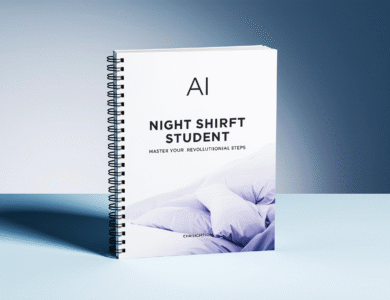AI Study Plans for Night-Shift Students: Build a Smarter Schedule That Works While You Work

You clock out when the sky is turning pink and the world is just waking up. Your body whispers “sleep,” your syllabus insists “study,” and you’re trying to honor both. If you’re juggling learning with night shifts, you’re not behind—you’re operating under different physics. The trick isn’t grinding harder; it’s designing AI study plans for night-shift students that match your energy, protect your sleep, and turn small windows into real progress. This guide shows you how to do exactly that—step by step, with tools, prompts, schedules, recipes, and evidence you can trust.
Why Night Shifts Disrupt Learning—and How AI Study Plans for Night-Shift Students Bridge the Gap
Night shifts scramble your circadian rhythm. That ripple touches attention, memory consolidation, and motivation—all the stuff studying needs. You don’t need one giant solution; you need small, repeatable systems that compensate for fatigue and capitalize on your unique peaks.
- What changes when you work nights
- Circadian misalignment: Your internal clock fights the sleep/wake pattern your shift imposes, which reduces alertness and working memory.
- Sleep debt: Short or irregular sleep degrades attention and increases errors, especially near shift end and early morning.
- Mood and motivation: Fatigue amplifies procrastination and makes hard tasks feel heavier.
- Why AI helps
- Personalization: You can adapt timing, difficulty, and format (text, audio, quiz) to your energy in real time.
- Automation: AI can parse syllabi, batch-create flashcards, schedule spaced repetition, and generate practice tests so you conserve willpower.
- Retrieval over rereading: AI makes it easy to practice active recall, the most efficient technique when tired.
- Credible sources to anchor your plan
- CDC/NIOSH on shift work and sleep health (circadian disruption, fatigue risks).
- American Academy of Sleep Medicine (AASM) on sleep duration and hygiene.
- Learning science: Dunlosky et al. (2013) on spacing and retrieval; Roediger & Karpicke (testing effect).
- Sleep and chronobiology journals on circadian misalignment and cognition.
What that means for you
- You’ll do deep work when you’re actually capable of it—not when a generic study blog says to.
- You’ll break material into smaller, quiz-friendly chunks.
- You’ll let AI handle repetitive setup so you can focus on understanding and practice.
Core Principles for Effective AI Study Plans for Night-Shift Students

- Time-block around your anchors:
- Pre-shift: short review to get momentum.
- On-shift breaks: microlearning.
- Post-shift: quick “capture” note only, then sleep.
- Off-days: 1–2 deep-focus blocks for heavy tasks.
- Match task type to energy:
- Low energy: flashcards, audio summaries, admin tasks.
- Medium energy: outlining, light problem practice.
- High energy: problem sets, essay drafting, labs.
- Use proven learning methods:
- Spaced repetition and retrieval practice beat passive rereading, especially under fatigue.
- Interleave topics to improve transfer and resilience.
- Automate the routine:
- Let AI convert readings to outlines/flashcards, generate quizzes, and schedule reviews.
- Protect sleep and ethics:
- Prioritize sleep blocks in your calendar.
- Use AI to learn and practice, not to submit unauthorized work.
Step-by-Step: Build Your AI Study Plan Around a Night Shift
Step 1: Map Your Schedule and Energy
Actions
- Add your fixed or rotating roster to your calendar.
- For 7–10 days, rate energy (1–5) at 3 times per day; note nap windows and commute time.
- Identify a repeatable “anchor” slot (e.g., 5:30–6:00 pm daily) you can defend on most days.
Prompts to try
- “Given this week’s shifts and my energy peaks at [times], create a study schedule with deep, medium, and light blocks. Include sleep and commute.”
- “Suggest two 10-minute microlearning windows on my work nights and what to study in them.”
Sources that help
- AASM guidelines on sleep duration (aim for regular total sleep over the week).
- CDC/NIOSH tips for shift workers (light exposure, naps).
Step 2: Turn Syllabi Into a Task Roadmap With AI
Actions
- Paste course objectives and deadlines into an AI tool and ask for:
- A week-by-week task list with estimates.
- Tags: deep, medium, light.
- A “must-do minimum” for tough weeks.
- Create checklists for each unit: learn, practice, test, review.
Prompts to try
- “From this syllabus, extract required tasks, order them by dependency, and tag deep/medium/light with time estimates.”
- “Build a ‘worst-week’ version with only essential tasks to pass quizzes and keep projects on track.”
Keep it clean
- Check your school’s AI policy; use AI for planning and practice, not for generating graded submissions.
Step 3: Schedule With Shift-Aware Blocks
Sample block structure
- Pre-shift (20–40 min): flashcards or quick retrieval on current unit.
- On-shift breaks (2×5–10 min): micro-quizzes or audio summaries.
- Post-shift (5–10 min): jot “next steps,” then start wind-down for sleep.
- Off-days (1–2 blocks of 60–90 min): deep work on problem sets, projects, or essays.
Prompts to try
- “Schedule spaced repetition for these flashcards over 6 weeks, avoiding the three hours before my usual sleep time.”
- “Split this chapter into four 10-minute quizzes for break-time review.”
Evidence snapshot
- Microlearning and distributed practice improve recall when time is fragmented.
- Short, controlled naps and strategic light exposure improve alertness for shift workers (aviation/healthcare fatigue research).
Step 4: Set Up AI-Powered Learning Systems
Flashcards
- Use AI to transform notes into Q→A cards; tag by chapter and difficulty.
- Sync with a spaced repetition app to automate your review queue.
Retrieval practice
- Have AI generate short-answer questions aligned to learning outcomes.
- Ask for mixed difficulty and cumulative review.
Summaries and “teach-back”
- Ask for a concise summary, an outline, and a “teach it to a beginner” explanation.
- Verify key claims with the original sources or textbooks.
Prompts to try
- “Create 25 short-answer questions from these notes. Mark easy/medium/hard and include an answer key.”
- “Summarize this article in 150 words, then produce a bullet outline of key arguments and evidence.”
Step 5: Weekly Review and Adjust
Metrics to track
- Study minutes by block type (deep/medium/light).
- Quiz accuracy (% correct) and items missed.
- Sleep hours and number of naps.
- Due-date risk (green/yellow/red).
Retro questions (ask AI or yourself)
- What worked?
- Where did fatigue derail me?
- What one change will make next week easier?
Prompts to try
- “Here’s last week’s log. Recommend adjustments to block timing and spacing intervals based on my accuracy and sleep.”
Sample Weekly AI Study Plans for Night-Shift Students (Fixed and Rotating)
11 pm–7 am (Fixed Nights)
- Pre-shift (7:15–8:00 pm): deep work while alert (problem sets or draft writing).
- Pre-shift warm-up (10:15–10:40 pm): flashcards and a 5-minute retrieval quiz.
- On-shift breaks: two 10-minute micro-quizzes; one 10-minute walk/stretch.
- Post-shift (8:00 am): capture next steps; start sleep routine (dark room, cool temp).
- Off-day: 2 deep blocks (60–90 min) separated by a 20–30 minute break.
AI automations
- Auto-generate flashcards from lecture notes.
- Auto-schedule spaced repetition reviews.
- Create weekly 10-question checks for each unit.
7 pm–7 am (12-Hour Shifts)
- Pre-shift (5:30–6:10 pm): medium tasks (outline readings, annotate slides).
- On-shift: two 10–15 minute reviews via audio summaries; one short walk.
- Post-shift: sleep first; later in the wake window do a 45–60 minute deep block.
- Off-days: prioritize projects and cumulative practice.
AI automations
- Convert dense readings to 5–10 minute audio briefings.
- Generate problem variations for practice sets.
Rotating Shifts (2-2-3 or Similar)
- Keep one small anchor (e.g., 5:30–6:00 pm review) daily.
- Transition days: only microlearning and admin tasks (no deep work).
- Heavier work 24–36 hours after a switch.
AI automations
- Rule-based planning: “If transition day, assign light tasks only.”
- Regenerate next week’s plan from the updated roster.
Sources to consult for scheduling
- AASM on sleep regularity and naps.
- Occupational health guidance on shift transitions and light exposure.
- Learning science on spacing and retrieval difficulty.
Sleep, Light, Caffeine, and Movement Protocols to Support Your Study Plan

Sleep: Guardrails You Can Actually Keep
- Aim for consistent total sleep across the week, even if split (core sleep + nap).
- Use blackout curtains, cool room, noise control, and a brief wind-down ritual.
- Protect the first 90 minutes after you lie down—no study, no screens.
H4: Quick sleep routine (10–15 minutes)
- Warm shower, light snack if needed.
- Dim lights, eye mask, gentle breathing (4-7-8 or box breathing).
- Set a “tomorrow start” note so your brain can switch off.
Light: Bright When You Need It, Dim When You Don’t
- Pre-work and early shift: bright light to boost alertness.
- Heading home and pre-sleep: avoid bright light; use sunglasses; block blue light.
- On days off, keep light exposure consistent to stabilize your anchor routine.
Caffeine: Useful, With a Curfew
- Use caffeine early in your wake period; avoid several hours before intended sleep.
- Pair caffeine with bright light for a bigger alertness bump.
- Don’t chase diminishing returns—track intake and timing.
Movement: Short Bursts Win
- 5–10 minute brisk walks or mobility circuits before or between study blocks.
- Light movement helps reset attention and reduces drowsiness.
References to explore
- AASM and Sleep Foundation on sleep hygiene and caffeine timing.
- Reviews on bright light therapy for shift workers.
- Occupational fatigue research for naps and alertness.
AI Tools and Prompts Library for Night-Shift Students
Planning and tasking
- Prompts to use:
- “Turn this syllabus into a week-by-week plan. Tag tasks deep/medium/light with time estimates and checkpoints.”
- “Given my shift calendar, schedule study blocks aligned with energy levels. Include commute and sleep.”
- What to look for:
- Calendar integration, reminders, and export to your phone.
- Rapid rescheduling when shifts change.
Learning and testing
- Prompts to use:
- “Generate 20 mixed-difficulty questions for these objectives. Include short explanations.”
- “Summarize this reading at three levels: 150 words, outline, and a plain-language teach-back.”
- What to look for:
- Spaced repetition apps (e.g., Anki/RemNote) for automated review.
- Tools that support audio for on-the-go learning.
Research support
- Prompts to use:
- “List peer-reviewed sources about [topic]. Provide links and a 1–2 sentence credibility note for each.”
- “Extract the key claims and evidence from this paper; flag any limitations.”
- What to watch out for:
- Verify citations and quotes.
- Follow your institution’s citation style and AI-use policy.
Track and Improve: Analytics for AI Study Plans for Night-Shift Students

What to track weekly
- Study minutes by type (deep/medium/light).
- Quiz accuracy and missed items (by topic).
- Sleep hours, naps, caffeine timing.
- Upcoming deadlines and risk flags.
H4: 10-minute weekly retro checklist
- What blocks felt easy? Hard?
- Which tasks slipped and why?
- What one change for next week (timing, task type, or scope)?
- Update your must-do minimum list if fatigue rose.
Why this works
- Self-regulated learning research shows that monitoring and adjusting based on feedback improves outcomes more than just “working harder.”
Quick Brain-Friendly Recipes for Night-Shift Study Sessions (Ingredient Tables)
You study better when your energy is steady. Aim for protein, complex carbs, and healthy fats; keep heavy meals away from sleep.
Overnight Protein Oats (Prep before shift; eat pre- or mid-shift)
| Ingredient | Amount | Notes |
|---|---|---|
| Rolled oats | 1/2 cup | Use gluten-free if needed |
| Greek yogurt | 1/2 cup | High protein; dairy-free alt ok |
| Milk or alt milk | 1/2–3/4 cup | Adjust texture |
| Chia seeds | 1 tbsp | Fiber for satiety |
| Frozen berries | 1/2 cup | Antioxidants |
| Peanut or almond butter | 1 tbsp | Healthy fats |
| Cinnamon | Pinch | Optional |
H4: Instructions
- Mix all ingredients in a jar; refrigerate 4+ hours.
- Add a drizzle of honey or a few nuts for crunch.
Savory Egg Wrap (Grab-and-go for post-nap study)
| Ingredient | Amount | Notes |
|---|---|---|
| Whole-grain tortilla | 1 | High fiber |
| Eggs or tofu scramble | 2 eggs / 3/4 cup | Protein |
| Spinach | 1 cup | Iron + folate |
| Avocado | 1/4 | Healthy fats |
| Salsa | 2 tbsp | Flavor; low sugar |
| Cheese (optional) | 1/4 cup | Satiety boost |
H4: Instructions
- Cook eggs/tofu, layer ingredients in tortilla, wrap, and grill lightly for 1–2 minutes.
Focus Smoothie (Pre-study boost on off-days)
| Ingredient | Amount | Notes |
|---|---|---|
| Frozen banana | 1/2 | Texture + carbs |
| Spinach | 1 cup | Micronutrients |
| Protein powder | 1 scoop | Your preferred type |
| Cold brew or decaf | 1/2 cup | Use decaf near sleep |
| Almond milk | 1 cup | Liquid base |
| Ground flax | 1 tbsp | Omega-3s |
H4: Instructions
- Blend until smooth; adjust thickness with ice or milk.
Common Pitfalls and Fixes for AI Study Plans on Night Shifts
- Pitfall: Overstuffed schedules that ignore sleep.
- Fix: Book sleep first, then add study blocks; use a must-do minimum list for tough weeks.
- Pitfall: Relying on summaries instead of practice.
- Fix: Pair summaries with retrieval; end every session with a 5-question quiz.
- Pitfall: Studying right before bed and wrecking sleep.
- Fix: Keep stimulating study away from your wind-down window; use light review earlier.
- Pitfall: Trusting AI without verification.
- Fix: Cross-check sources; keep a quick verification checklist.
- Pitfall: Ignoring transitions on rotating shifts.
- Fix: Make transition days microlearning-only, then ramp up 24–36 hours later.
Accessibility, Budget, and Ethics
- Accessibility
- Use text-to-speech, captions, transcripts, and dyslexia-friendly fonts.
- Keep contrast high and use readable formatting for late-night eyes.
- Budget
- Free options cover most needs (open-source spaced repetition, free note apps).
- Use free trials for premium features during heavy exam weeks.
- Ethics
- Use AI for planning, practice, and explanations.
- Don’t submit AI-generated work as your own; cite or disclose when required.

Conclusion
Your schedule is unconventional, not unworkable. With AI study plans for night-shift students, you can study when your brain’s most capable, automate the boring bits, and build momentum in small, honest blocks. Protect your sleep, keep your plans simple, and lean on retrieval practice. You’re not chasing perfection—you’re building a system that quietly gets you across the finish line week after week.
Call to action
- Want a personalized weekly plan? Paste your next 7 days of shifts and your due dates below—I’ll map a study schedule with deep/medium/light blocks you can follow right away.
- Prefer a template? Say “PLAN” and you’ll get a fill-in-the-blanks study-plan worksheet and prompt pack.
- AI planner tools night-shift students: How 9 Boost GPA
- best AI study planner app for night shift students: 6 reasons to choose the right tool
FAQ: AI Study Plans for Night-Shift Students
How do I start an AI Study Plan for Night-Shift Students if my shifts change every week?
- Anchor one short review block at the same clock time daily (even 15–20 minutes). Regenerate your plan each week from your new roster and keep transition days for microlearning only.
How many hours should you study on workdays vs. off-days?
- Workdays: 30–60 minutes total via short bursts (pre-shift + breaks).
- Off-days: 1–3 hours of deep work, divided into 60–90 minute blocks with real breaks.
Can AI actually help when you’re exhausted after a night shift?
- Yes. Convert readings to audio, run quick 5–10 minute quizzes, and use spaced repetition. Save deep tasks for off-days or your personal energy peak.
What’s the best spacing schedule for night-shift learners?
- Start with 1 day, 3 days, 7 days, then weekly—adjust based on quiz results. If accuracy drops, bring the item forward; if it’s easy, push it out.
Is using AI for study plans considered cheating?
- Planning, summaries, and practice questions are generally fine; submitting AI-generated answers as your own is not. Follow your institution’s policy and cite/disclose when required.
What AI prompts work best for night-shift students?
- “Create a week-by-week plan from this syllabus; tag tasks by difficulty.”
- “Generate 20 mixed-difficulty retrieval questions covering these outcomes.”
- “Turn this reading into a 7-minute audio summary and an outline with key evidence.”
How should nursing or healthcare night-shifters adapt?
- Use case-based questions and dosage calculations on breaks; schedule skills practice on off-days; align quizzes to NCLEX-style or specialty exam formats.
How do you handle caffeine in AI Study Plans for Night-Shift Students?
- Use caffeine early in your wake window and taper well before your intended sleep. Pair with bright light early and blue-light reduction before bed.
What if you fall behind because of fatigue?
- Switch to your must-do minimum list (critical readings, flashcards for current unit, due-now tasks). Use microlearning only for 48–72 hours, then ramp back up.
How do you keep motivation when your schedule feels upside down?
- Track streaks for tiny wins, keep an anchor review time, and end sessions by noting the “next small step” so you never start cold.
References and Further Reading
- Centers for Disease Control and Prevention (CDC) / NIOSH: Work schedules and sleep; shift work and fatigue.
- American Academy of Sleep Medicine (AASM): Adult sleep recommendations and sleep hygiene guidance.
- Dunlosky, J. et al. (2013). Improving students’ learning with effective learning techniques (spacing, retrieval).
- Roediger, H. & Karpicke, J.: The testing effect and retrieval practice.
- Sleep Foundation: Sleep hygiene and caffeine timing.
- Chronobiology and shift work research (e.g., Sleep; Journal of Biological Rhythms) on circadian misalignment and cognition.
If you want, drop your next week’s roster and course deadlines, and you’ll get a custom plan back—clear, ethical, and built for your real life.



